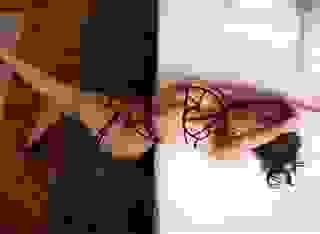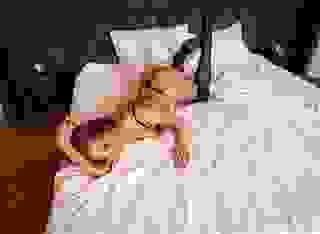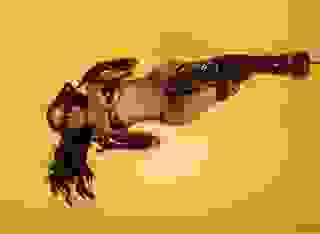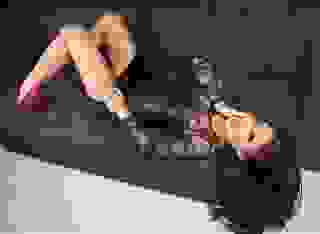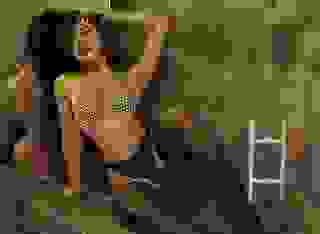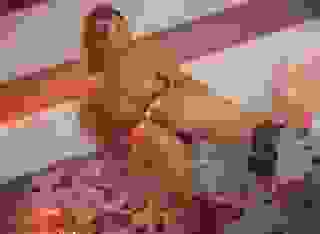Note: You can change font size, font face, and turn on dark mode by clicking the "A" icon tab in the Story Info Box.
You can temporarily switch back to a Classic Literotica® experience during our ongoing public Beta testing. Please consider leaving feedback on issues you experience or suggest improvements.
Click hereCloser to hand, their sleds skimmed over or crunched through the crystalline firn -- the ancient snow that had thawed and refrozen many times. In places the firn was harder or softer depending on the weather conditions.
Despite the cold, the men were sweating as they manhandled the sleds up the hill. By their side, the glacier creaked and groaned breaking the silence like a soul in torment as it slowly slid on its journey to the sea. From time to time Chugach and Iluliaq made forays onto the ice but each time they said that the surface was still too fractured and dangerous to cross.
Onwards and upwards. Tarleton was struck by the idea that they might be the first white men to ever come this far as the old Vikings usually kept to the coast. He mentioned that idea to Hatley.
"As far as you know," said Hatley. "What about the old Inuit legends of long-lost peoples?"
Tarleton laughed. "Oh, those. Every culture has its ideas about vanished civilizations. Look at the Atlantis legends."
Hatley grunted as he helped shove the sled over a particularly steep incline.
"Have you ever read the Pnak...?" Hatley said, before hurriedly breaking off as he saw Tarleton's raised eyebrows. "Oh, just some old book Dr. Welham recommended I read. Part of it was a history about how the tall, grey-eyed men of the cities of Lomar fought and were defeated by the Inutos as the ice age started. Legend has it a watchman in a tower fell under an enchanted sleep.
"Of course, this happened many thousands of years ago and the names and geography have changed since then but, from his reading, Dr. Welham thinks that what is now Baffin Island could once have been part of Lomar. Before the ice sheets covered it all of course," Hatley added.
Tarleton laughed. "It all sounds a bit far-fetched to me. Grey-eyed men of Lomar. I mean, everyone knows there were no civilizations before the ice age. Society hadn't evolved beyond the Mesolithic hunter-gatherer stage by then."
Hatley glanced at his friend as they labored. "There are some very ancient manuscripts and places in the world that give an alternative view," he said.
Before Tarleton could argue further, the ground levelled out. The huskies took up the strain, the sled surging forwards with a jolt. The mountain flattened out to reveal a vast rocky plateau covered with boulders and debris. The ever present wind had scoured the terrain clear of snow.
"Looks almost like Leng, don't you think, Arthur?" Dr. Welham said in an undertone to Hatley.
Tarleton wasn't sure what Dr. Welham meant by that although he was aware that the professor had visited Mongolia back in 1898, returning in 1913 with Hatley and others and come back with some strange and inexplicable artefacts which he had only shown to a select handful of enquirers. According to University rumor, these were now stored in closely guarded vaults beneath the Library.
"Sarkia fits the bill better, don't you think?" Hatley replied after a moment.
CHAPTER 4: THE DISCOVERY IN THE CAVE.
By now, the men and dogs were all tired after hauling the heavy-laden sleds uphill and were glad of the chance to rest. Some built windbreaks out of rubble whilst others pitched tents, pounding the pegs deep into the permafrost. They lit camp stoves and held their hands to the fires as they waited for their dinner of tinned stew to heat up. Even though it was June, the north wind made it bitterly cold.
"We'll stay here for the night; carry on tomorrow," Dr. Welham told the men. "Hopefully we'll soon find a place to safely cross the glacier."
Feeling his strength return after eating, Tarleton took his bag and rock hammer and set off to look for interesting specimens. Most of the others also took the opportunity to explore the plateau. Tarleton was chipping off an interesting piece of feldspar for his collection when he heard something over the howl of the wind. Tarleton paused and listened. There it was again. A shout from the far end of the level. He leaped to his feet. Had a polar bear attacked someone? This far from the coast, their guides hadn't thought there would be much threat from the carnivores but it was always possible.
Springing up from the outcrop, turning to face the shout, Tarleton saw a man waving a ski pole in the air. The man didn't seem hurt and the cry sounded like one of excitement rather than fear. The man waved his pole again with more vigor. Other scientists crossed the small plain hurrying over to him. What had he found? What scientific discovery had he made, Tarleton wondered.
Dropping the feldspar into his bag, Tarleton hurried across the rock-strewn plain. Exposed to the full force of the wind, it took Tarleton longer than he expected. The wind's force seemed to rise as if it was trying to push him back -- keeping him away from the discovery. The others seemed to be having similar problems. Worse, the wind seemed to be shrieking in his ears in a half-forgotten language. Tarleton couldn't understand the words but he made out their intent. "Go back, go back now," the wind seemed to be saying to him.
Ignoring his fears, Tarleton carried on. Even as he ran, Tarleton noticed that something was strange about this part of the plain. The rocks were mostly white marbles, some veined with delicate reds and pinks. He knew that marble was a metamorphic rock and so not uncommon in volcanic areas but these seemed more like blocks than rocks. Too many were of a similar size and shape and appeared to have unusually squared corners.
If he didn't know better, Tarleton would have said that they'd fallen from a long-toppled tower. Which was absolutely impossible in an uninhabited part of Baffin Island. The most of humanity this plateau would ever have seen was a random Inuit hunting party taking a short-cut around the fjord. No, these blocks -- no, rocks his mind amended must have been sand-blasted by grit. A most unusual phenomenon he told himself. He would like the chance to investigate further.
By now most of the other scientists and handlers had reached the site and they were all standing around looking at something on the ground as if hypnotized. Tarleton pushed his way through the group.
The find was worth getting excited about. Even Tarleton, who wasn't an expert historian, could see that. Craning his neck to look, Tarleton knew he was looking at one of the most important archaeological finds of the young century; perhaps it would become the most famous since Heinrich Schliemann first excavated the ruins of Troy in 1871 to '72.
Towards the back of a shallow cave, little more than a hollow scooped out of a rising knoll on the plain, lay three bodies. The cave had sheltered the bodies from the ever-rushing wind. From their positions they seemed to have fought to the death.
The first two were bodies of shorter, more thick-set man who appeared to be some kind of Inuit. Like yet unlike the modern inhabitants of the region. What remained of the desiccated skin on their skulls appeared to have been tattooed. When they died, they wore fur coats and leggings and also simple leather helmets under their hoods. Their robes were embroidered with designs that no-one had ever seen on any modern native design. They resembled stylized octopuses.
One man lay on a round wooden shield and carried a sword shaped length of wood set with razor-sharp obsidian flakes that reminded Tarleton of an Aztec macuahuitl. The sharp blackness of the shards gleamed evilly in the half-light. The other held a broken harpoon edged with shark's teeth.
Yet if these long dead corpses were strange enough, it was the third that drew the scientists' attention. The third was of a tall man who would have stood well over six foot in life. He wore a warmly quilted jerkin and trousers, now faded to a dull russet color which were tucked into boots. Over his jerkin he wore a shaped but corroded bronze cuirass and his skull looked out from under a broken helmet with a crest of feathers running along the ridge. Lying next to his claw-like hand was a slender bronze sword which was thrust through the body of the Inuit-type with the macuahuitl.
Yet, even allowing for centuries, maybe millennia of lying exposed in this frozen tomb, the men saw that this corpse was not that of any Arctic native. His long limbs and the shape of his skull showed that the man was once of the Caucasian race. There were even remnants of light brown hair attached to his bony skull.
The scientists looked at the scene with amazement.
"I'm surprised some animal -- an Arctic fox -- never got them," said one man.
"I guess this proves that this was Helluland then. Looks like this Viking got on the wrong side of these skraelings," said a man called Greavey.
"skraelings?" the first man asked.
"What the Vikings called the Indians when they reached the Americas. They fought and the Indians drove them out," Greavey explained.
Hatley shook his head. In a strangely high-pitched voice he said, "Can't you see, you fools? Does that man look like a Viking to you? Have you ever seen a Viking with a helmet like that -- or carrying a bronze sword?
"No, this was a man of Lomar -- that land that fell beneath the ice after attacks from the invading Inutos from out of the west..."
Dr. Welham stepped forwards. "That will do, Hatley. We've no proof of that yet -- it's only speculation. We must carefully record these bodies and then take them back to base camp for analysis. Who's got the camera?"
Hatley was so excited, he wouldn't be quiet. "Look at all these stones? Could this be the marble city of Olathoe itself?" He pointed up at the surrounding mountains. "Are those the peaks of Noton and Kadiphonek that are spoken of in the..."
This time Dr. Welham actually dragged Hatley away from the rest of the group and spoke to him. The wind had got up and was now blowing half a gale and a few flakes of snow came with it. Because of the wind, Tarleton couldn't hear what Dr. Welham said to Hatley.
However, Greavey had fetched the camera from the sled and was busy photographing the bodies in situ and from different angles to get the fullest record of their find. By the time Greavey had finished, Dr. Welham and Hatley returned. No more was said about the lost land of Lomar.
Dr. Welham gathered everyone around. "As you'll appreciate, this is an incredible find. One of international significance. We'll carefully wrap these bodies and take them back to base camp for further investigation." He sent Tarleton and Greavey back to bring up the sleds.
As soon as they returned Chugach and Iluliaq approached Dr. Welham. "Please leave them here, Doctor. Is bad luck disturbing the dead. Let them lie where they fell," Chugach asked, the signs of distress evident on his broad, strong face.
"Nonsense, man. This is a major scientific discovery that will revolutionize the history of the Arctic. Imagine the impact that Europeans reaching Canada sometime during the Bronze Age will have!" He pointed at the weapons carried by the two Inuit-type bodies. "Let alone the knowledge that they fought warlike Eskimos!"
Dr. Welham was excited and wouldn't listen to the two guides' pleas. Under his guidance, the scientists carefully lifted the body of the first Inuit-type -- an Inutos -- as Hatley insisted on calling it. However, the body was more fragile than it appeared. It had been lying out for millennia and was little more than dust and fibers preserved only by the constant sub-zero air of the plateau.
As soon as it was touched, the corpse crumbled away to dust, leaving only the larger bones like the femurs and skull itself as well as some carved stones and animal teeth as jewelry. Sadly, Hatley lifted up the obsidian edged macuahuitl and wrapped it in a blanket.
The body of the second warrior was no stronger and also disintegrated as soon as the scientists tried to move it. Even the harpoon fell to pieces leaving shark's teeth scattered over the floor of the cave.
After those disappointments, there was a debate about the wisdom of moving the European body. It seemed a shame to try and move the remains if all that would happen was that it would also fall to pieces. Maybe because it wasn't of one of their distant ancestors, Chugach and Iluliaq didn't seem as bothered about this body.
In the end it was decided to make the attempt -- if only because it might be many years before Miskatonic sent another expedition this way. But sadly the same thing happened. Underneath its bronze breastplate, the friable body crumbled to nothing, leaving only dust, fragments of cloth and the larger bones.
Hatley removed the cuirass and sword. Examining the weapon, he was excited by markings inscribed on the blade. Showing them to Dr. Welham they considered them like, yet unlike, the very earliest pre-Minoan writings discovered at Knossos and speculated if maybe there were links between the two cultures.
As Dr. Welham and Hatley stowed what was left of their discoveries on the sleds, Tarleton went into the now empty cave. It was like something in the wind was calling him; summoning his presence. Stepping over where the bodies had lain, he made his way to the back of the shallow cave. The place was in semi-darkness as the low Arctic sun never reached the interior. The cave seemed eerie and he wondered what had brought those long-forgotten men here to kill each other all those years ago. Towards the back there seemed to have a slight rock fall and rubble littered the floor.
His boots crunching over the debris, his head bowed low as the ceiling lowered, Tarleton made his way to the back of the hollow. It looked like everyone had already fetched out everything of value. All the same, one of the rocks caught Tarleton's geologist's eye. It seemed out of place amongst the granites forming the bulk of the cave. It seemed like -- no it couldn't be, but after what he'd seen anything was possible -- a piece of jade.
Moving some rubble that had fallen onto the green stone, Tarleton lifted it up. Blowing grit from its surface, Tarleton was shocked by what he held. So aghast, he cried out and dropped the blasphemous abomination. He would have turned and fled but his shriek had attracted attention. Dr. Welham himself ran into the cave. Spotting the jade on the floor he lifted it up. As he did so, his face went pale -- as white as the snowy mountains outside. Dr. Welham's mouth opened and closed before he could speak.
On the face of it, the statue wasn't too horrible. It was approximately a foot tall and of a starved humanoid with long outstretched arms tipped with talons. The figure had wide bulging eyes set too wide in its head and a fanged mouth open in terrible hunger or a soul-blasting scream. Every rib was exquisitely carved. Yet there were too many of them, giving the torso a snake-like appearance. Its legs were long, inhumanly long, as if the figure was striding forwards ready to devour the world.
But there was something about the carving; something deep and terrible that hinted of the benighted frozen wastes beyond the stars. Something inhuman and monstrous about the statue that spoke of worlds and times far, far removed from this.
Dr. Welham looked at it with terror and revulsion and was about to fling the statue away until Hatley entered the cave. He paused and, like Tarleton and Dr. Welham, seemed horrified for a moment. But then his eyes lit up with desire.
He took the statue out of Dr. Welham's nerveless grasp and wrapped the hideous object up in a fold of cloth. As soon as it was hidden, an air of normality seemed to return.
"I wonder if it can be?" Hatley murmured. "B'gnu-Thun; the Soul-Chilling Ice-God. It would fit." He sounded excited.
"Ssh. That's enough," said Dr. Welham, glancing over at Tarleton. He rubbed his mitten over his forehead as if trying to rub away a headache.
The three men left the cave and stepped out onto the wind-swept plain. To Tarleton it seemed that even during their short time in the cave, the temperature had dropped several degrees. The wind had got up and was sweeping down from the icy mountains to the north. Tarleton wrapped his coat tighter around himself and adjusted his scarf over his lower face so that only his eyes peered out.
Chugach and Iluliaq were freeing the sleds and fitting the huskies into the traces. Tarleton was no expert but the dogs seemed nervous and anxious and were playing up making the two guides' work more difficult. Tarleton helped the guides settle the dogs before they set out.
"Mush, mush," Chugach called, cracking his whip, and the lead sled set off down the trail. The huskies bounded away, as if eager to leave the wind-swept plain. To Tarleton's eyes, the weather was definitely getting worse. The mountain tops were now hidden by low-lying clouds and the wind was blowing much stronger. Flurries of snow gusted around them, soon covering the plain in a thin layer of white.
"Looks like it's going to be a bad one," Hatley said to Tarleton as they heaved their sled over a patch of shale.
Tarleton nodded, glad that they were returning to base camp. "What was that all about earlier, Arthur?" he asked over the shriek of the gale blowing straight down the mountain.
"What?" said Hatley.
"Bug-Thing the Ice God. And the land of Lomar or whatever it was."
Hatley looked away as he adjusted a tarpaulin covering the load. "Nothing -- just native legends," he said evasively. But he wouldn't meet Tarleton's eye as he spoke.
CHAPTER 5: WHITE-OUT ON THE TRAIL.
Shortly after this conversation, Tarleton had no time to think further about their strange discoveries. Even going downhill, the blizzard caught them well before they reached the glacier that had forced them inland. A wall of white swept over them. Tarleton had heard of the dreaded white-outs but this was the first he'd experienced. It would be useless as well as irresponsibly dangerous to carry on and Chugach, after speaking with his brother, suggested they stop and wait it out. Accordingly, the team drew the sleds together and the men hunkered down in their lea whilst the huskies curled up with their noses covered by their tails.
The weather on Baffin Island was always unpredictable and at the start of the short summer there was always a chance of a return to winter weather but this snowfall was the worst the two Inuit had ever seen. Quickly the dogs were hummocks underneath the snow and the men were sunk in misery. The temperature dropped still further until their beards and eyebrows were frosted. Even through their scarves it was painful to draw breath.
Yet it was the wind that was the worst. The howling, roaring, shrieking wind that sounded like the call of the banshee. The wind that clutched and clawed and chilled to the bone. The wind dropping the temperature to far below freezing, the wind that would eventually kill unless it eased soon.
The temperature dropped still more and the snowstorm intensified. The two Inuits put their heads together. They said this was the worst storm of the worst winter -- far worse than any legend from their grandfather's grandfather time. Yet this was no winter storm. This was far worse. Supernatural. Otherworldly.
For hours the team crouched behind the minimal shelter of their sleds. Yet it was the snow itself that saved them from the heat-sapping wind. Gradually it formed an insulating blanket around the men as they huddled together, saving their lives. They cleared snow away from their faces and sat, lost in their own thoughts until the gale finally blew itself out.
The wind slowed, the shrieks and screams of its banshee wails subsided to a low moan and the snow eased until only the final few flurries fell. With difficulty, their joints numbed by the strength-sapping cold, every muscle seemingly locked in place the men slowly stood, knocking inches of snow from their bodies. They looked about in amazement. Where there had once been a rocky trail leading from the plain, there was now just an expanse of whiteness. Looking up, even the flanking mountains were covered in white snow.
